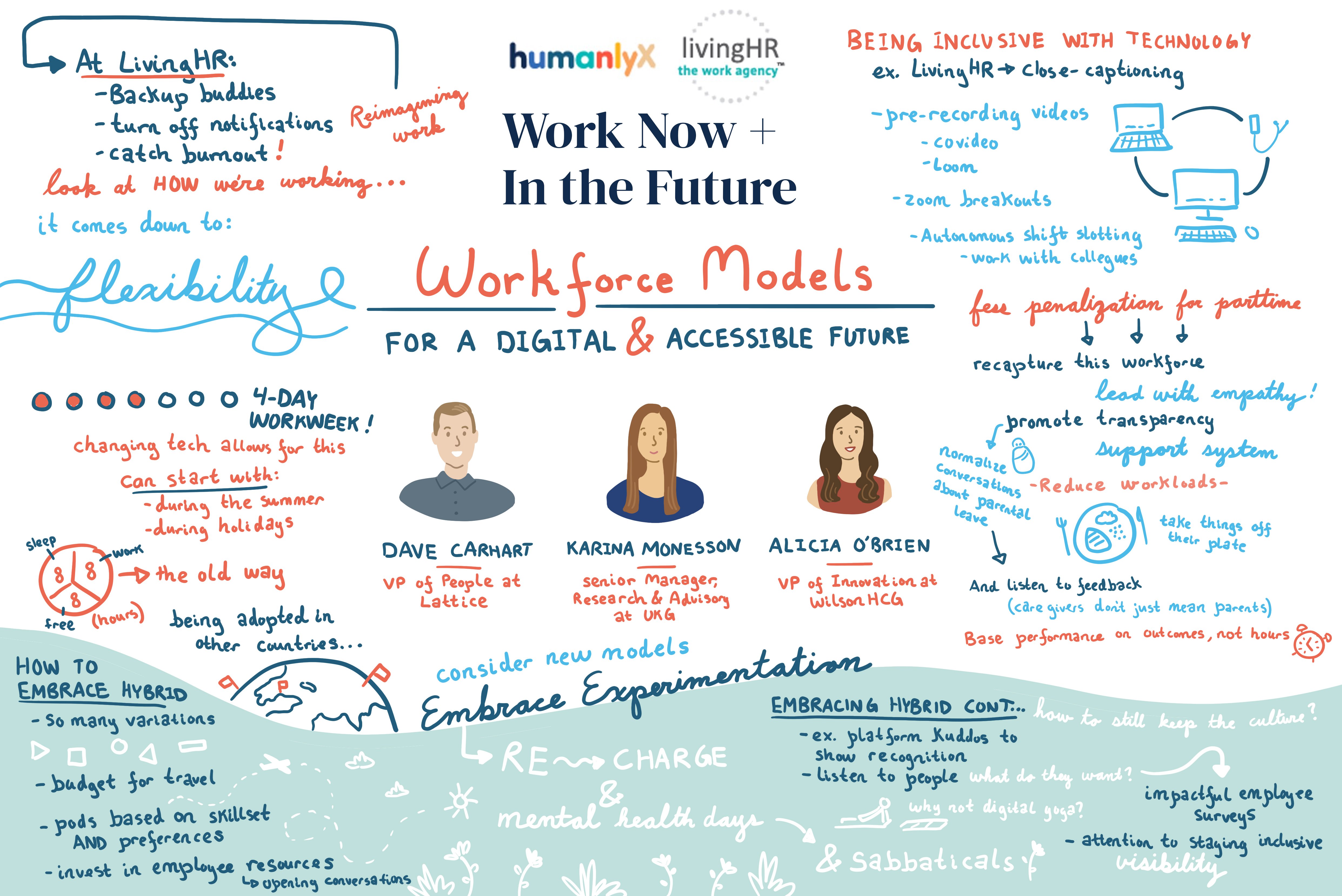[Panel recap] How to manage workforce models for a digital and accessible future
April 8, 2022Alicia O’Brien, WilsonHCG’s vice president of innovation, participated in a panel discussion with livingHR about workforce models. Joining her were Karina Monesson, senior manager of research and advisory at UKG, and Dave Carhart, vice president of people at Lattice. They discussed how to better support employees in doing their best work — and how to reimagine the constructs.
ICYMI, there are some of the highlights below.
You can also watch the recording here.

Image credit: Aleyna Moeller
Be flexible, and cater to employee needs.
What we heard: Burnout has been widespread for years, causing many employees to reevaluate their mental health and priorities. Employees are at the point of demanding flexible hours and being able to disconnect from work during off hours.
What we understood: New work models must be considered and based on how employees work best. Productivity, retention and flexibility are all part of the puzzle. Trends, such as 4-day work weeks, autonomous shift switching and company sabbaticals, are at the forefront of conversations.
What is required: Employers must be willing to embrace experimentation and ask employees what they want, as what works for one department might not work for another. Poll employees and act accordingly, but know agility will also be required as preferences change.
Lead with empathy for the best results.
What we heard: Managers practicing compassion toward employees has powerful results when it comes to making them feel valued. This makes employees feel heard and gives them permission to have frank conversations about what they want.
What we understood: Creating a support system internally helps everyone understand the unique challenges everyone’s facing on a day-to-day basis. Leader-to-direct report and other relationships in the organization are strengthened by this empathetic approach and makes a big impact over time.
What is required: Executives modeling behaviors of flexibility will empower employees to feel secure doing the same. Being public vocal about needing to sign off early makes it OK for everyone else to do the same when needed.
Use tech to enhance human connection and workplace culture.
What we heard: It’s not enough to simply have communication platforms. You must use technology to augment workplace culture through recognition, events and more.
What we understood: Being a tech-forward organization often doesn’t require a hefty budget or resources. Many connection points can be achieved by prioritizing human-centric communication such as employee resource groups (ERGs) and enabling peer-to-peer recognition. Software, like Kudos for rewards, is a good way to facilitate recognition companywide.
What is required: Reward employees who have a passion for furthering community in your organization. Whether it’s virtual yoga sessions, ERG projects or in-person incentive trips, show your commitment to bringing people together on all fronts.
[Guide]: Take control of your talent acquisition technology
Be intentionally inclusive in everything you do.
What we heard: Whether it’s putting live captioning on meetings or making your website accessible, it’s important to continually research tech and tools that will help you practice diversity, equity, inclusion and belonging (DEIB) in remote and hybrid environments.
What we understood: Platforms, such as Covideo, minimize meeting fatigue and expand important company messages into easy-to-digest content. Not only does this give employees time back in their day, but it’s also a way to let people take information in a way that works best for them.
What is required: Creating equitable spaces means respecting your employees’ preferences and acknowledging everyone equally, regardless of hybrid or remote environments. Base performance on outcomes and trackable KPIs (rather than hours worked) so people don’t get misrepresented from an idle Teams icon, for instance.
Welcome part-timers and caregivers back.
What we heard: Many caregivers left the workforce during the pandemic. As more return, they may need flexibility, including reduced hours and unexpected time off to account for their caregiving responsibilities.
What we understood: Reducing hours and expectations is an overlooked solution due to the traditional rigidity that comes with full-time work. Be open to other options and policies to better accommodate part-time workers — this can be a phenomenal retention tool.
What is required: Part-timers shouldn’t be penalized, but instead welcomed, to retain more brilliant minds. Promote a culture of transparency so caregivers feel supported and valued internally. Don't overlook current full-timers who may need to temporarily reduce their hours to handle other priorities in their lives.
About WilsonHCG
WilsonHCG is an award-winning, global leader in total talent solutions. Operating as a strategic partner, it helps some of the world’s most admired brands build comprehensive talent functions. With a global presence spanning more than 65 countries and six continents, WilsonHCG provides a full suite of configurable talent services including recruitment process outsourcing (RPO), executive search, contingent workforce solutions, talent consulting and talent intelligence.


